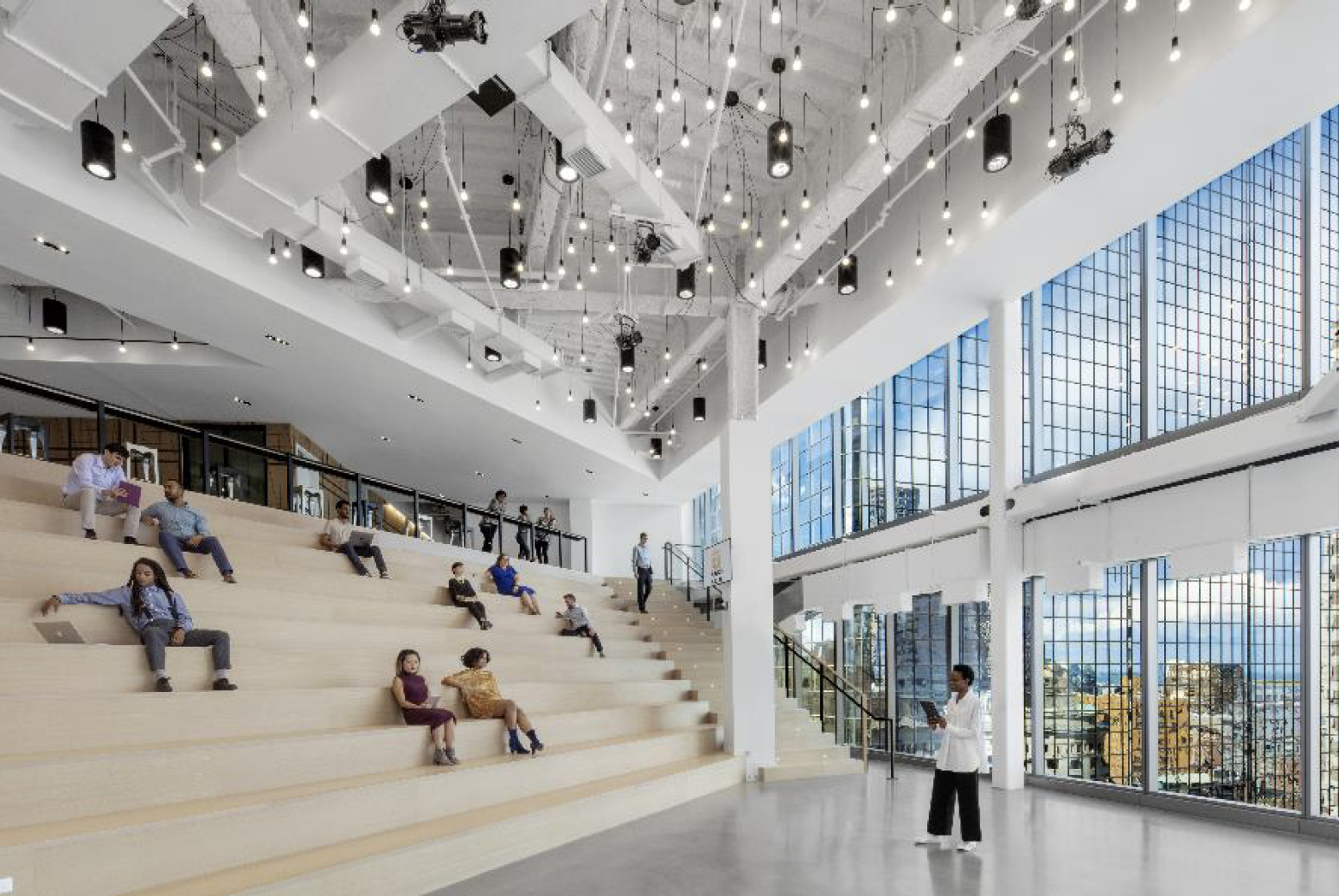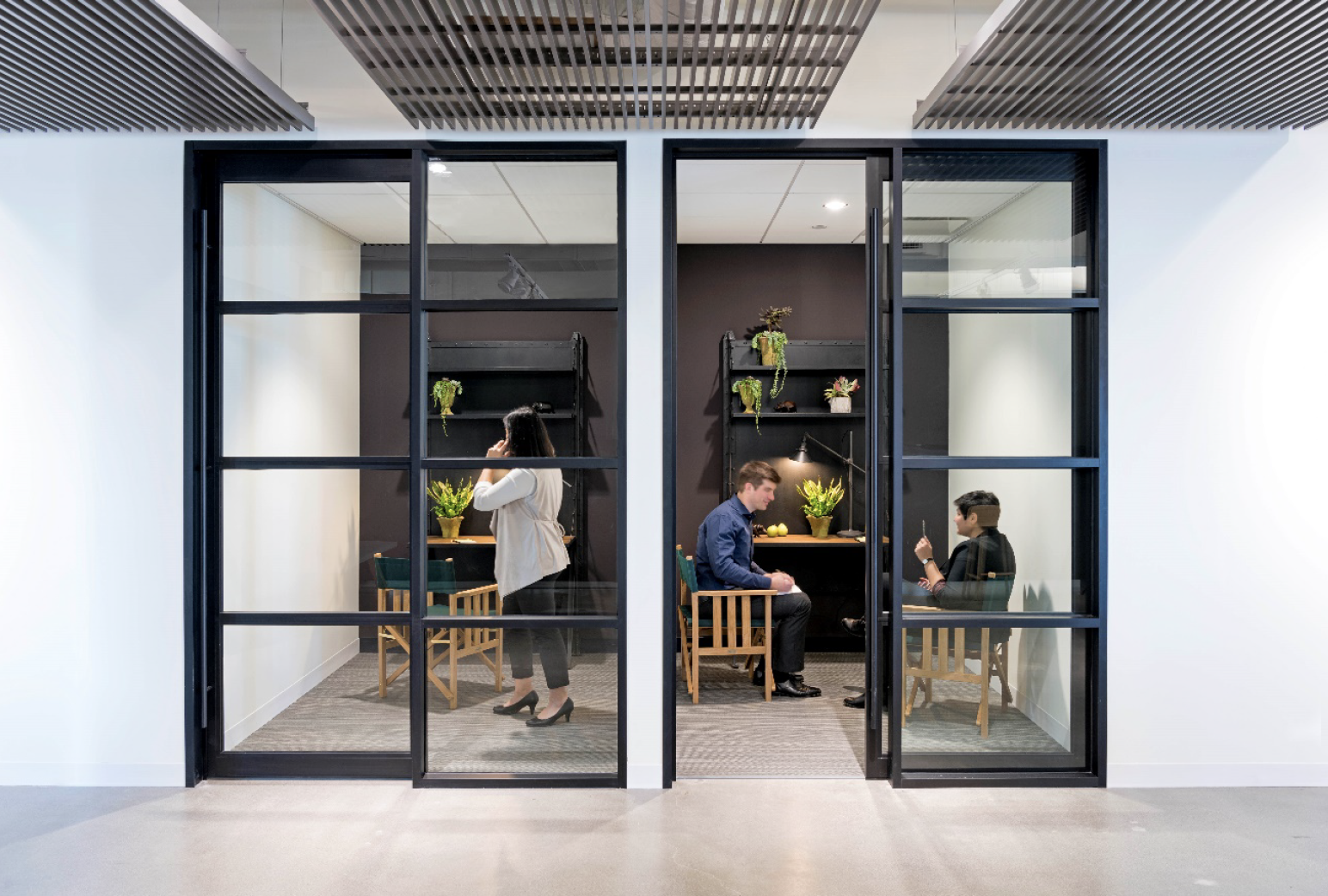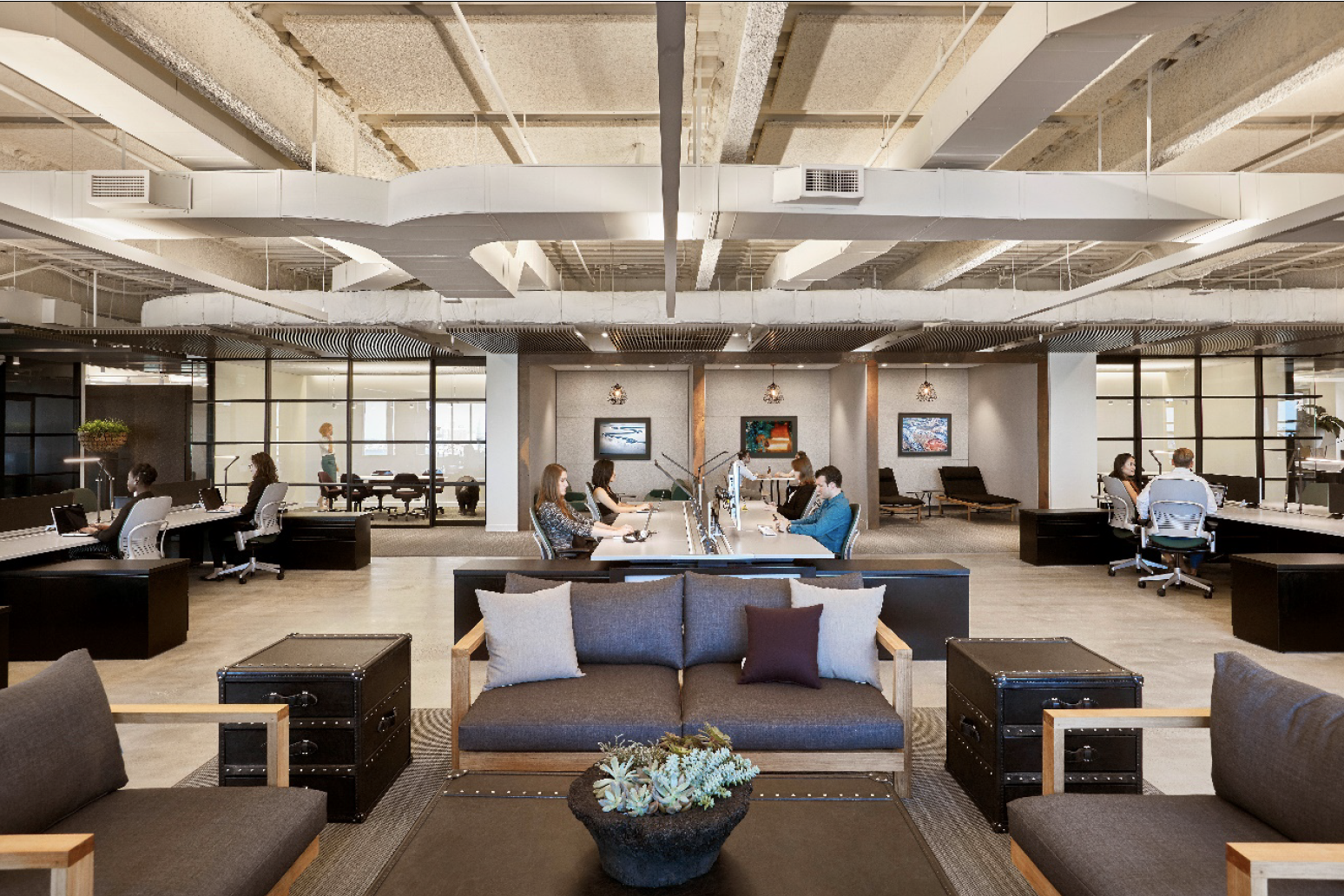
A double-height amphitheater in the new Boston office of Publicis Groupe is used for company-wide presentations, community gatherings, and client receptions. The flexible space can adapt easily to a multitude of other purposes. ©Eric Laignel
The coronavirus has turned the workplace upside down. When we do go back to the office, it will be changed forever. The team of workplace strategists and designers at Elkus Manfredi focus on re-imagining the post-pandemic workplace. While solutions will look different for every organization, all will share the same mission: to ignite the creative innovation that each company needs to thrive. The world is still in the midst of ongoing unknowns, but we have arrived at some overarching design strategies that start with understanding where we are today, articulating goals, and preparing for rapid prototyping in anticipation of an uncertain future.
Where are we now?
Even before the pandemic arrived, workplaces were evolving. Many companies had partially or fully embraced activity-based working to leverage real estate, improve utilization metrics, and bring people together in a way that encourages interaction and community.
Then came the pandemic and the office became a health risk. Companies quickly instituted greater spacing between employees, added divider panels, closed off conference rooms, upgraded air filtration, and established safety and cleaning protocols to reassure employees that they could come back safely when the time is right.
While this was happening, employees were busy proving that working from home was not only possible but productive. Now that we have lived through a solid period of remote working, however, everyone agrees there is enormous room for improvement. Employees are feeling lonely, disengaged, and without mentorship. They’re anxious about the future and looking for leadership. Individual productivity may be high, but collaboration and managerial productivity are slipping, and the speed of innovation is declining.
The trust that is built and the nuanced cues experienced in face-to-face interaction have yet to be replicated in our largely virtual world. This is becoming a critical workplace factor as employees are given the choice of when they work in the office, if at all, and also as all working becomes hybrid — interfacing with colleagues in person, virtually, and a mix of both.

Small rooms offer acoustic privacy for team collaborations, virtual calls, and individual focused work. ©Jasper Sanidad
What are the goals?
In the past year, we have all learned what we value through what we have lost. For corporations, that means the creative collaborations — which are the lifeblood of innovation — that can only be fully realized through proximity. To revive and grow that collaboration in a hybrid world will demand leadership laser-focused on the employee experience.
Research is indicating that going forward, at least 50% of office workers will choose to work from home at least part of each week. Some will work two or three days a week in the office, some more, some less, but this means that at least 90% of the office workforce will be experiencing hybrid working throughout each workday. While individual focused work may be accomplished at home, interactive and collaborative efforts will most often happen among a hybrid team of in-office and remote members. When people come to the office for in-person collaborative work, they will still need tools and places to do individual work or attend virtual meetings. Added to the mix are the criteria of ESG (Environmental, Social, and Governance), with their focus on sustainability and ethical impact. ESG factors have taken on new urgency and are changing the way investors evaluate companies.
The advent of hybrid working makes the physical workplace even more important than it was before the pandemic. The workplace is the culture-keeper of an organization, reinforcing its goals, mission, and values. It provides, supports, and fosters the employee experience, and it nurtures the essential human need for connection with others. Additionally, just as the pandemic has established our ability to work from anywhere, it has also brought about the infusion of the workplace with wellbeing measures for the whole person — body, mind, and spirit. This has provided a stronger-than-ever sense of community and a platform for creativity that brings different points of view together, resulting in collaborative innovation that just does not happen working solely from home. Companies will have to be more forward-thinking than ever before to create workplaces that employees choose to go to even when they don’t have to. Because it is no longer a mandate, the workplace must become a magnet.
How does a company foster employee engagement in the new hybrid work environment? One tool we use with great success at Elkus Manfredi is a process we call “co-creation,” which is an inclusive methodology that engages everyone at a company to participate in designing their workspace, from the mailroom to the executive suite. We ask everyone, “What do you need to be most productive, efficient, and collaborative at your job? What are your roadblocks?” We merge the information we gather with behavioral management methodologies in order to design workplace solutions that are concrete and actionable.
Almost one year into remote working, most everyone agrees that the tools and training in how to manage in this new world have not kept pace — while individual productivity has gone up, shortfalls in collaborative and managerial productivity are in need of our attention. IT experts will become partners with designers to understand how existing technologies might be creatively repurposed for the hybrid working model, and what new technologies are emerging so that workspaces seamlessly integrate and support them.

For a financial client, this office floor plan created different neighborhoods that are distinct but all keep traders close to the action, ready to conduct transactions. © Garrett Rowland
So what's next?
Management structure is coming back and will be reinvented for a hybrid world
What will the physical workspace look like that supports new management styles? It must be flexible, with the ability to pivot and adapt to the new ways of working to respond to the evolution of management that is coming. For a road map, lessons can be learned from companies that had a distributed workforce pre-pandemic, knowing that the future will ultimately look different even from models that were effective in the recent past.
Testing, failing fast, and refining
The changes needed to accommodate hybrid working will be different for each company. Over the next several years and possibly well beyond, we will all be living in a world of rapid prototyping, where what might have taken years pre-pandemic is instituted in months. Testing will include options for physical space and technology, but will be driven by new management philosophies and workplace policies. This means designing for the unknown, and for flexibility and change, not for permanence.
Wellness comes first
The work environment will be focused on safety, health, and wellbeing. Beyond fresh air, natural light, and fitness, it has evolved to a more inclusive perspective that transcends physical health to include mental and emotional health. Companies will dive even deeper into addressing the root causes of, and solutions for, these challenges.
Maximizing inclusion
The priorities must ensure that hybrid working works for everyone. Bringing as many voices as possible is imperative to reduce inequities and ensure that all employees are welcome, valued, and supported. This is not only good for individuals, it’s good for business — maximizing the diversity of voices at the table also maximizes innovative ideas.
Reimagining workspace
Open fields of workstations are not ideal hybrid working conditions. Imagine everyone on different virtual calls at the same time and you can almost hear the problem. Instead, these open spaces will become part of an array of “neighborhoods” where collaboration happens. Sure, they will still be for individual work, but will flex to accommodate rapidly for collaboration. Workers do not want to go somewhere else in the office to collaborate or connect, and need the ability to shift tasks right there in a neighborhood. Passive learning through proximity to mentors has been lost during remote working, so that will be an important consideration and a significant driver for employees returning to the office.
Collaboration equals innovation, and innovation is how businesses survive. Through the recalibration of people, places, and technology, the hybrid workplace that supports collaboration will emerge. Solutions will be different for each industry and company, but what they will have in common is that they will be supremely flexible and inclusive places for innovation and creativity — magnet spaces that engage employees like never before.
